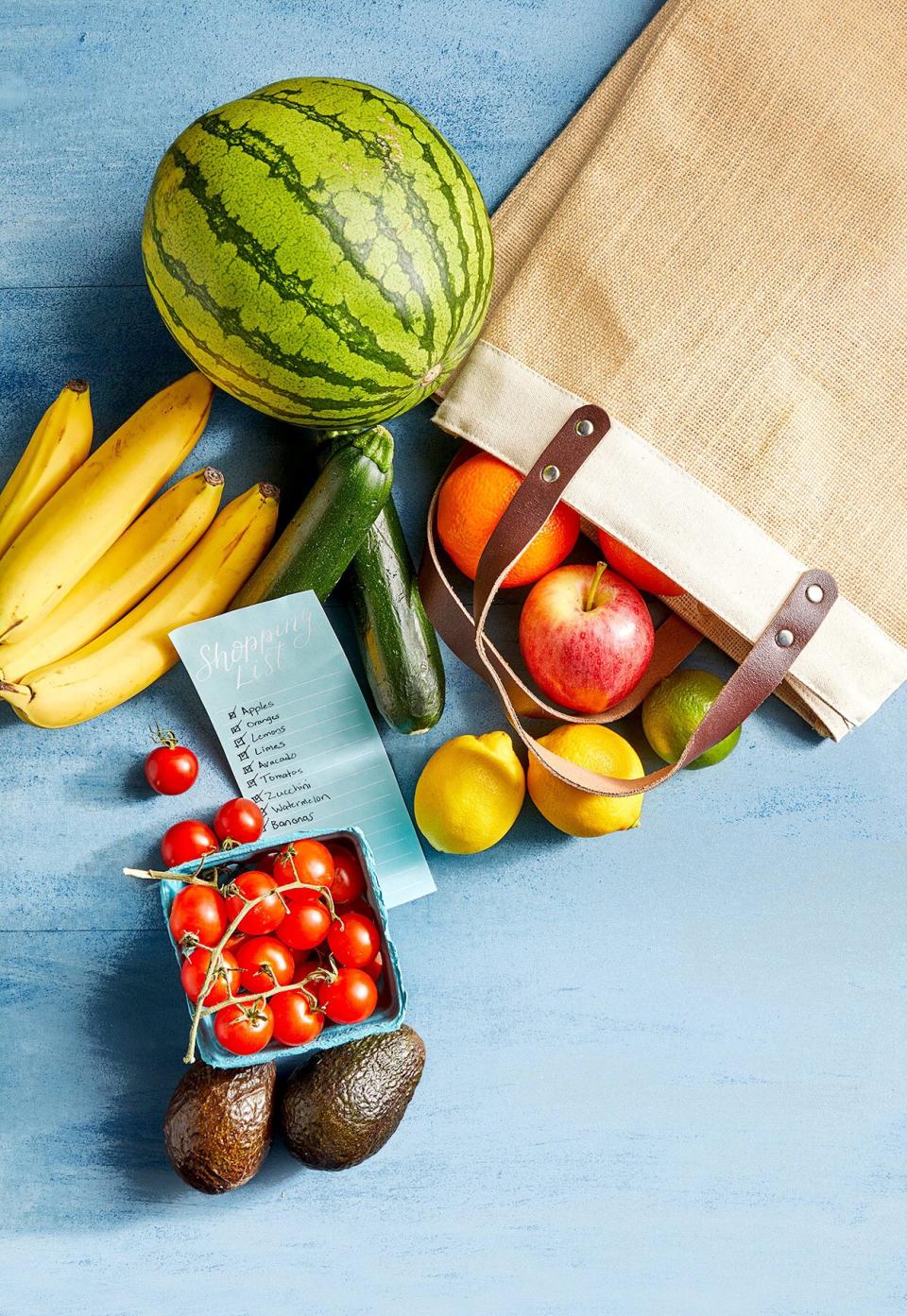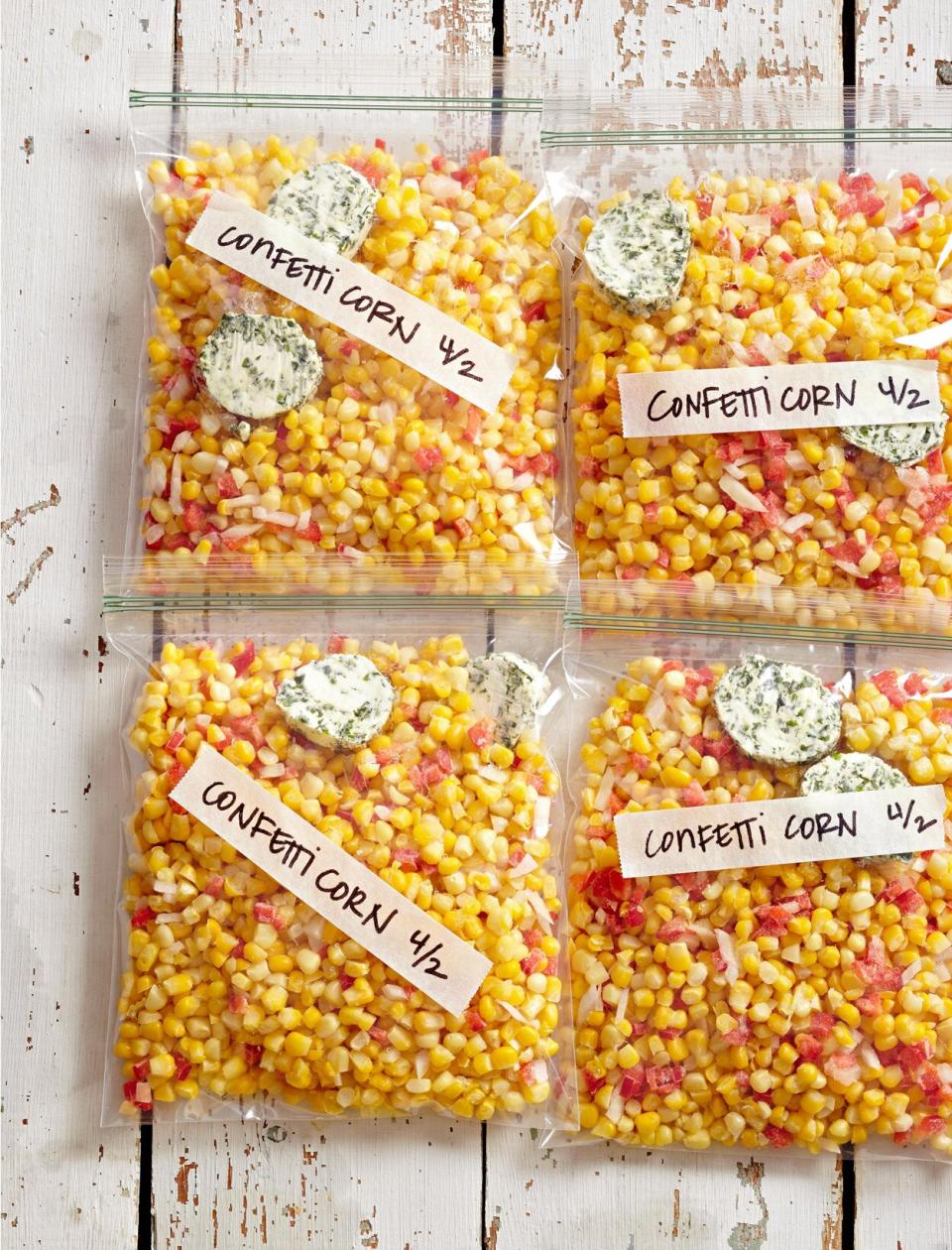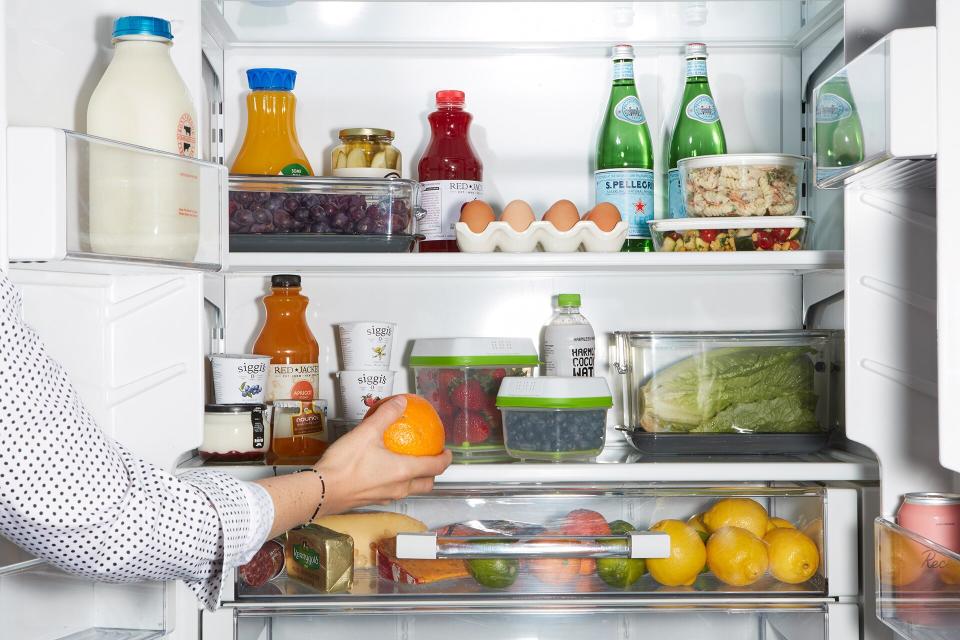14 Smart Tips to Cut Kitchen Waste and Save Money
If you're filling your garbage bin with containers of expired food or fresh herbs that went limp before you used them, you're wasting valuable resources. No matter how you slice it, groceries are a financial investment. From leafy greens and freshly baked bread to frozen and canned goods, it pays to make the most of your purchases. Knowing how to reduce food waste is not only more sustainable for the environment, but it will also help you be more efficient with your time in the kitchen, too. With ideas for menu planning, food prep, and better storage, these food waste solutions will make your paydays and produce stretch further.

Laura Moss
1. Plan a Menu
Before you go to the grocery store, plan your menus for the week. Planning ahead helps you have everything you need on hand (preventing extra trips to the store), allows you to prepare some foods in advance for faster meal prep later, and fits leftovers into your menu.
Try to stop food waste by incorporating perishable goods already at home to inspire your food selections. Another helpful tip is including in-season fruits and vegetables because they should be both better quality and less expensive. And don't forget to consult your calendar (to make sure you'll be home or don't have other dinner plans) so that you're planning to cook the right number of meals and portions.
Once you've got a plan, create a grocery list to support the menus; that way, the food you buy is already designated for a specific meal. This helps eliminate impulse purchases, too.
2. Stick to the List
We've all heard the cautionary tales about shopping on an empty stomach or meandering through the store without an idea of what to cook. Once you're at the store, stick to what's on the list you created.
It's OK to allow some room for flexibility: If green peppers are out of stock, find an alternative that works. If you had apples on your list, but you're just as happy with pears and they're on sale, buy the pears. However, if there's a big sale on a bulk item you rarely use and it isn't on your list, pass it by. It's likely you'll end up wasting more than you would save by deviating from your list.
Related: 6 Easy Ways to Eat Healthier on a Budget

Blaine Moats
3. Shop Critically
Pay attention to what you're actually picking up at the store and where it fits in your meal plan, especially with perishables. Brown bananas won't make it to the end of the week, but a hard, unripe avocado won't be ready for tonight's guacamole, either. It's helpful to learn the difference between "sell-by," "use-by," "best-by," and expiration dates, and what they mean for different types of goods.
Avoid bulk purchases of produce and dairy, which have a limited shelf life. Bulk purchases of meat, on the other hand, minimize costs and can easily be frozen for use later. Skipping pre-cut beef and poultry, and opting for larger pieces you cut at home, will also add to the savings.
4. Restock Wisely
When you start restocking your fridge and pantry, do what the grocery store stockers do: Move older items to the front so they are used first, and put the new purchases with a longer shelf life to the back. This way you're more likely to use food before it expires. Also, avoid overpacking the refrigerator. Cold air must be able to circulate around refrigerated foods to keep them properly chilled. Decreased circulation results in faster decomposition of foods.
Related: Genius Refrigerator Organization Ideas to Make Your Fridge More Functional
5. Store Produce Correctly
Fruits and veggies vary in freshness factor, so do your homework and learn the best way to store the produce you buy most often. For example, do not refrigerate potatoes; store bananas away from other fruits (like avocados and apples), and never wash berries until right before you're ready to use them. Pantry foods also need some attention. Did you know you shouldn't be storing spices close to heat, and nuts will last longer if you keep them in the fridge? Little tips like these can add days to your purchases.
Related: How to Wash Fruits and Vegetables to Reduce Risk of Illness and Pesticides
6. Prepare Fresh Herbs Properly
Fresh herbs can last up to 2 weeks when properly prepped and stored. To keep a few days, trim stem ends and place them in a tall glass with fresh water. Change the water when it becomes cloudy. For longer storage of herbs like cilantro and parsley, wash, dry completely, then gently roll the herbs (stems on) in paper towels. Place in zip-top storage bags, expel air from the bag, and seal. These will last 1 to 2 weeks in the refrigerator. If you won't have the chance to use fresh herbs before they wilt, dry them to make homemade spices.
7. Cook Only What You Need
When it's time to cook, prepare an appropriate amount of food. For example, there is no need for eight servings of short ribs if you live alone. Learn to pare down or expand recipes to suit your household size, and then buy, prepare, and cook accordingly. Alternatively, you can cook a recipe that makes too much food if you include the leftovers in your meal plans. Maybe you've worked in leftovers for lunch twice that week, or have planned for two different dishes that require shredded chicken breast that you can cook at one time. Like grocery shopping, menu planning really comes in handy here.
8. Strategically Serve Portions
Whether it's a table for two or 22, allow people to serve themselves. It might be automatic for the cook to dish up in the kitchen, especially when cooking for a small household, but self-service helps prevent the food waste that's left on plates at the end of a meal.
It's also important not to let foods sit out too long. This can be especially hard when entertaining, but the result is compromised food safety and a lot of kitchen waste. Foods should not be out at room temperature for more than 2 hours unless the hot foods are kept hot and cold foods kept cold. Similarly, you should limit the amount of time (1 hour) that foods are left outside when dining in hot weather.
Related: 5 Foods You Didn't Know You Should Store in the Fridge
9. Freeze Your Leftovers
To freeze your leftovers properly, first cool the food to room temperature. Then place it in freezer-safe containers, date the containers, and clearly label the contents. It's helpful to include a use-by date, too, to help you quickly identify what to eat first.
Related: 38 Make-Ahead Recipes to Stock Your Freezer with Right Now
Although you're probably no stranger to freezing leftovers, you might be surprised by all the foods that can be frozen for longer life, like sauces, herbs, cooked rice and grains, and butter.
Remember to add these frozen food sources to your meal plans; it'll help you use them before they're too old and stop you from spending money on ingredients you already have.

Jason Donnelly
10. Preserve Excess Fruits and Veggies
Produce turns quickly, and it's a costly waste when you don't use it. Be proactive by preserving the remaining fruits and vegetables during your meal prep.
Fresh fruit can be frozen in ½- or 1-cup portions in freezer bags and used in smoothies instead of ice. That means added nutrients and no watering down your smoothie. Here's a waste-busting tip: If you're going for a banana smoothie, don't throw away the peel! Banana peels chopped and frozen in zip-top freezer bags make a great "ice cream" type treat when blended with a little milk (dairy or dairy-free milk will work). Veggies can be diced and prepped for the freezer, too, ready for use in future meals. And if your freezer is full, there's always canning! Learn more about canning and freezing fruits.
10. Save Liquids for Later
Everyone thinks to freeze food, but what about beverages? If you have leftover coffee in the morning, you might be pouring dollars down the drain. Instead, pour cold coffee into ice cube trays and freeze. The same goes for coffee creamer, milk, and half-and-half. Use them later for homemade coffeehouse-style frozen drinks and iced coffees. You not only get the most out of a costly grocery item, but you also cut out that high-price coffee-shop beverage.
Leftover fruit juice can be frozen, too. Use these fruity cubes for smoothies, popsicles, slushy drinks for the kids, or cocktails for the adults, without ice to water down your drink!
11. Reheat Leftovers Like a Pro
Waste isn't exclusive to home cooking. How often have you gotten a to-go box, only to throw it out later? There are better ways to reheat your takeaway than nuking it in the microwave. Fries are rarely, if ever, great the next day, but have you tried frying them up on the stovetop? Give breaded chicken the chance to crisp up in the oven, and try turning leftover pasta into a casserole.

Peter Ardito
12. Store Smarter
Poor storage bites into your budget in a number of ways. For starters, relying on too many single-use plastics (like sandwich bags and plastic wraps) will have you frequently making more purchases. Cut them out with reusable plastic or glass storage options.
Another way storage makes waste is if you aren't properly packaging food before hitting the fridge or freezer. Unless packed in airtight containers air sneaks in and dries food out, impacting what you can or want to eat. Make sure you're taking the time to securely prep and store your leftovers and freezer foods.
Try packing leftovers in single servings. This way, if there is a lot remaining, you can put some straight into the freezer for later, and leave a portion or two in the fridge for now. Storing in single- or family-size portions also means you don't have to divvy it up later, which can be hard (no pun intended) if the leftovers are frozen in one large container.
13. Use What You Have
Instead of throwing out produce that's getting soft and spotted, make something that doesn't need the ingredient to be perfect looking. For example, a browning avocado might not be great for toast, but it can make a flavorful addition to an egg salad. Dry green beans might be tough when roasted yet a nutritious addition to a casserole. You can also find ways to use typically discarded items like vegetable peels, stems, and leaves on Pinterest and in cookbooks. Get the absolute best bang for your buck by utilizing every part of what you purchase.
Related: Don't Toss That Cheese Rind! Here Are 12 Ways to Repurpose Food Scraps
14. Find Alternative Disposal
Many of the scraps left behind during food prep, or on a plate after a meal, could be turned into gardener's gold: compost! By composting food waste (i.e. egg shells, coffee grounds, and fruit/veggie peels), you're not only making good use of your food scraps but creating nutritious food for your plants. If you're using the remnants to create fertilizer for your garden, or simply tossing the in bins collected by the city, your waste still turns into a valuable, sustainable resource. It's like reinvesting your original purchase.
If you find yourself with perishables that you're worried you won't use in time, try reaching out to local food banks, soup kitchens, and shelters. Do the same for shelf-stable products. Organizations relying on donations may be adept at cooking and meal planning on a tight timeline.
Reducing food waste takes practice. Things like seasonal menu planning and carefully storing different types of produce require extra effort. Sometimes a walk down the wrong aisle can put you in the mood for tacos when they're not on the menu. It may take some time to learn and for the effort to become routine, but the results are worth it. Maximize how you shop, prep, and store your food, and watch your grocery bills shrink as a result! Your budget and your conscience will be happy.

